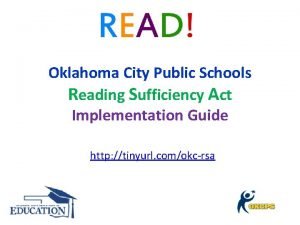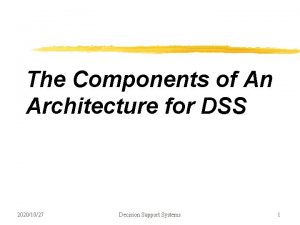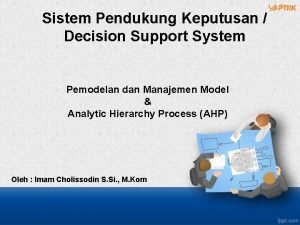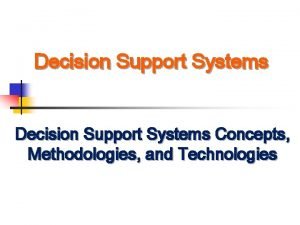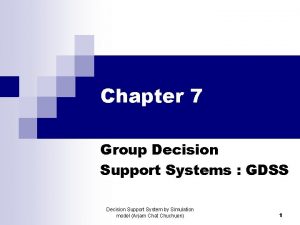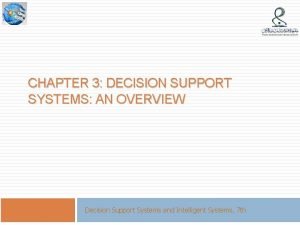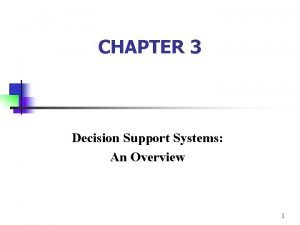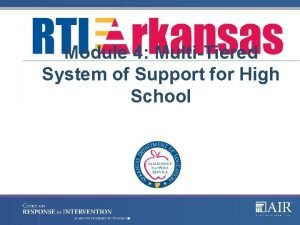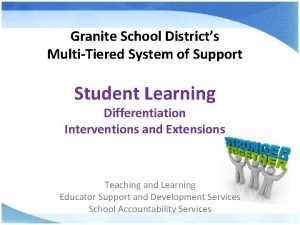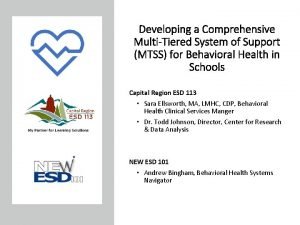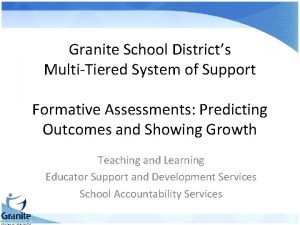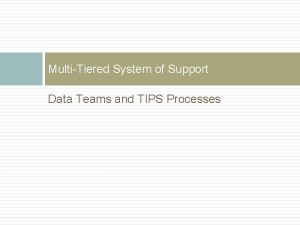Screeners in a MultiTiered System of Support College



















- Slides: 19

Screeners in a Multi-Tiered System of Support College Career Readiness and Success Center Jenny Scala Senior Researcher, American Institutes for Research December 2016 Copyright © 2016 American Institutes for Research. All rights reserved.

Introductions Using participant list as master list Please share: § Your name § Work role and location § Favorite aspect of winter holidays 2

Screeners in a Multi-Tiered System of Support College Career Readiness and Success Center Jenny Scala Senior Researcher, American Institutes for Research December 2016 Copyright © 2016 American Institutes for Research. All rights reserved.

Session Overview Agenda: § Review of multi-tiered systems of support (MTSS) § Discuss screeners in MTSS § Explore early warning systems in MTSS context 4

Overview of MTSS 5

What is MTSS? § Prevention framework that • Organizes building-level resources to address individual students’ academic or behavioral needs • Integrates assessment and a continuum of instruction and interventions • Incorporates multiple intervention tiers that vary in intensity • Provides timely intervention for students who are at risk for poor learning outcomes or may need enrichment opportunities Response to intervention (RTI) and positive behavioral interventions and supports (PBIS) are examples of MTSS. 6

Center for Response to Intervention 7

Key Components of MTSS 1. Research-driven practices (academic, behavioral, attendance) 2. Screening 3. Progress monitoring 4. Interventions that increase in intensity across a continuum of tiers 5. Data used to inform decisions across the continuum of the framework 8

Screeners 9

Screening § Identify students at risk for poor outcomes (e. g. , learning, behavioral, graduation) § Identify students who need additional assessment (i. e. , progress monitoring) and instruction or support (i. e. , targeted or intensive) § Provide data on the effectiveness of the core instruction, curriculum, and schoolwide supports § Should be valid and reliable 10

Early Treatment of Diabetic Retinopathy Study (ETDRS) Chart http: //www. visionaware. org/info/your-eye-condition/eye-health/low-visionexamination/1235 11

Overview of Early Warning Systems and Early Warning Indicators 1

A Definition An early warning system (EWS) relies on readily available data housed at the school to accomplish the following: § Predict which students are at risk of missing key education milestones § Target resources to support off-track students early § Examine patterns and identify school issues 13

Implementation Pathway of EWS Synthesize Research Validate Indicators Customize and Develop Tools and Supports Launch and Implement Early Warning Intervention Monitoring System Assess and Improve Processes 14

Components of an EWS § Early warning indicators https: //www. pinterest. com/aab 378/blueprints/ § Implementation process http: //www. planningengineer. net/construction-project-management-essential-4 terms-you-should-know/ 15

Early Warning Indicators § Early warning indicator identify students at risk of dropping out of high school: • • Typically includes attendance and academic indicators Indicators should be validated for local context Reviewed at multiple times during the school year Behavior doesn’t have the research nationally to confidently support using as an indicator 16

Early Warning Indicators for High School Graduation Indicator Middle School High School Attendance Missing 20% or more Missing 10% or more Grade Point Average Not applicable 2. 0 or lower on 4. 0 scale Course Performance Failing ELA or math Failing any course Chicago On Track Not applicable Credit deficient for promotion to 10 th grade AND one or more failures in core courses 17

Citations for EWI Thresholds § Allensworth, E. M. , & Easton, J. Q. (2005). The on-track indicator as a predicator of high school graduation. Chicago, IL: University of Chicago Consortium on Chicago School Research. Retrieved from https: //consortium. uchicago. edu/sites/default/files/publications/p 78. pdf § Allensworth, E. M. , & Easton, J. Q. (2007). What matters for staying on-track and graduating in Chicago public high schools: A close look at course grades, failures, and attendance in the freshman year. Chicago, IL: University of Chicago Consortium on Chicago School Research. Retrieved from http: //ccsr. uchicago. edu/sites/default/files/publications/07%20 What%20 Matters%20 Final. pdf § Balfanz, R. , Herzog, L. , & Mac Iver, D. J. (2007). Preventing student disengagement and keeping students on the graduation path in urban middle-grades schools: Early identification and effective interventions. Educational Psychologist, 42(4), 223– 235. § Bowers, A. J. , Sprott, R. , & Taff, S. A. (2013). Do we know who will drop out? A review of the predictors of dropping out of high school: precision, sensitivity, and specificity. The High School Journal, 96(2), 77– 100. § Heppen, J. B. , & Therriault, S. B. (2008). Developing early warning systems to identify potential high school dropouts. Washington, DC: National High School Center. Retrieved from http: //files. eric. ed. gov/ fulltext/ED 521558. pdf 18

Jenny Scala jscala@air. org 1000 Thomas Jefferson Street NW Washington, DC 20007 800 -634 -0503 www. ccrscenter. org | ccrscenter@air. org 19
 Forefront math screener
Forefront math screener Oklahoma reading sufficiency act
Oklahoma reading sufficiency act Signal words
Signal words Expert system vs decision support system
Expert system vs decision support system Dss ai
Dss ai Expert system and decision support system
Expert system and decision support system Pix
Pix Wake tech admissions
Wake tech admissions Early college high school at midland college
Early college high school at midland college Voyage estimating decision support system
Voyage estimating decision support system Components of decision support system
Components of decision support system Contoh spk motor honda
Contoh spk motor honda What is a management support system
What is a management support system How did the county unit system support segregation?
How did the county unit system support segregation? Executive support systems
Executive support systems Components of decision support system
Components of decision support system Purpose of enterprise decision support system
Purpose of enterprise decision support system Gdss
Gdss Bi vs dss
Bi vs dss Components of decision support system
Components of decision support system

